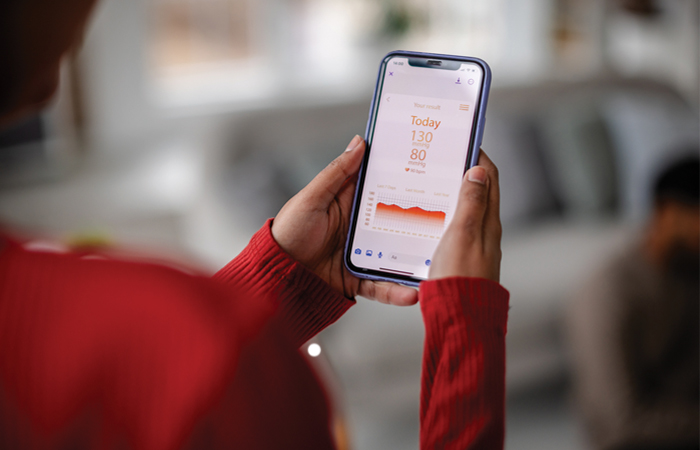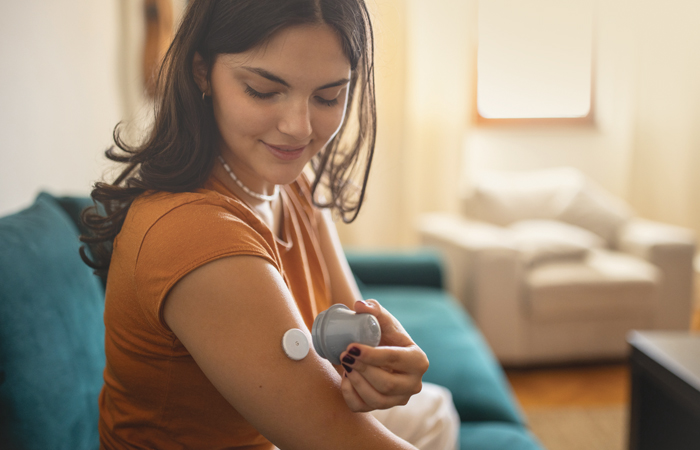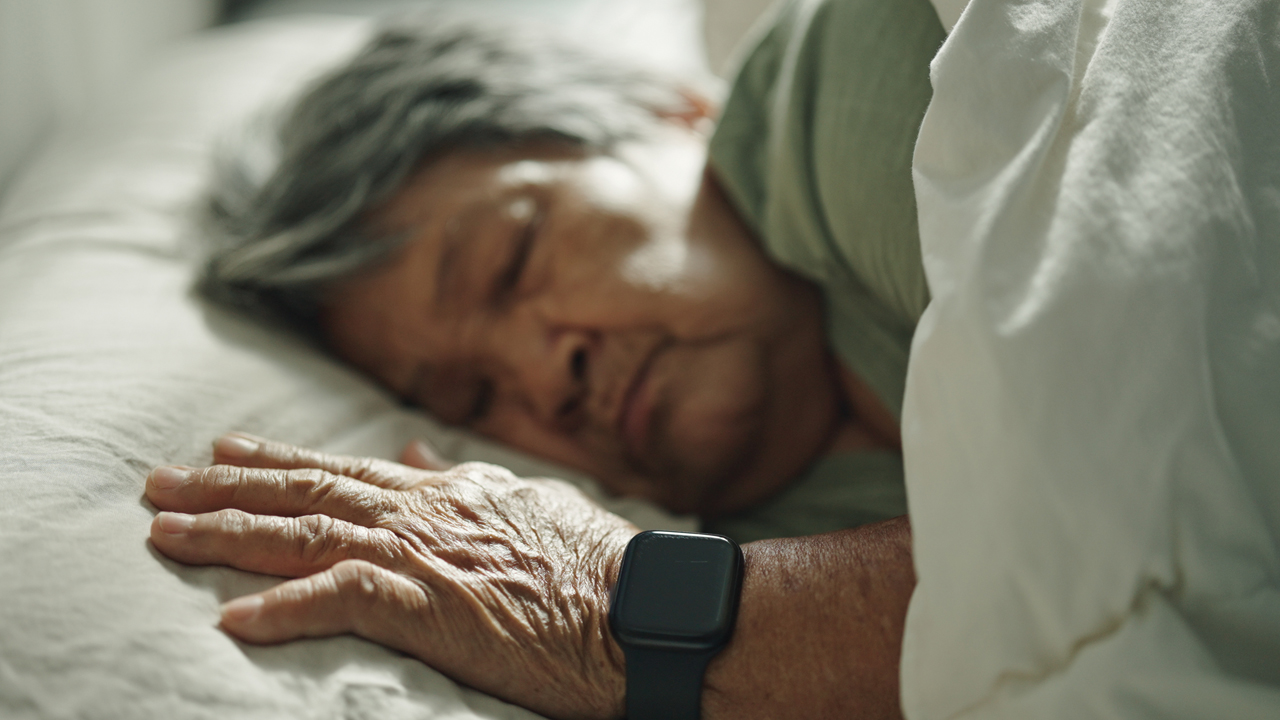In OTC
Follow this topic
Bookmark
Record learning outcomes
Most people use apps on a daily basis, and it seems that for almost every aspect of one’s life, there is an app that promises to make it easier. The healthcare space is not immune to this, and there is an abundance of technology on the market, from apps that measure sleep quality or wearables that track physical health, to monitoring devices that can diagnose hypertension. These advents can be useful, lifesaving even, but with so many to choose from, customers may be overwhelmed. Many people may also be wary of adding another app to their lives or, conversely, may become too obsessed with monitoring every aspect of their health.
The pharmacy team thus have a crucial role to play in educating customers on these different types of devices and ensure that they are using them safely. “Digital health tools, when guided by evidence and supported by clinician input, have great potential to enhance personalised care,” says Farzana Haq, clinical pharmacist and independent prescriber. “Our role is not only to dispense medicines but also to empower patients with knowledge – and in 2025, that will include digital literacy.”
All part of the Plan
“When evidence-based and user-friendly, digital tools can significantly enhance self-monitoring and early detection of health changes,” says Farzana. “NICE and NHS England both advocate for the use of digital health technology to support personalised care, especially in managing long-term conditions like diabetes, hypertension and COPD.”
This attitude is in line with the NHS’s Long Term Plan which, as well as other areas, is heavily focused on shifting from treating sickness to preventing illness. “Our NHS Long Term Plan aims to support people to live longer, healthier lives through helping them to make healthier lifestyle choices and treating avoidable illness early on,” says the NHS.
There is also an emphasis on using the technology available to make care easier to access for the public, while allowing health care professionals to make use of a wider range of data to complement in-person care. “[Digital technology] has great potential to improve how the NHS delivers its services in a new and modern way; providing faster, safer and more convenient care.” Digital technology in this light can be extremely educational for customers, allowing them to monitor their health and alert them when something may be amiss.
“Our role is not only to dispense medicines but also to empower patients with knowledge”

The deal with devices
Pharmacy teams can recommend a variety of monitoring devices depending on the condition customers have. Farzana notes a few of the devices endorsed by the NHS and/or NICE:
- “Continuous Glucose Monitoring (CGM): [Certain devices] are widely used across the UK NHS, particularly in type 1 diabetes and selected type 2 diabetes patients using insulin. These tools offer real-time interstitial glucose readings, alerts for hypo/hyperglycaemia, and app-based data sharing, all ofwhich support more informed clinical decision-making and improve time-in-range outcomes. NICE recommends CGM as part of diabetes care where appropriate”
- “Home Blood Pressure Monitoring (HBPM): Recommended by NICE and the Scottish Intercollegiate Guidelines Network (SIGN), HBPM supports hypertension diagnosis and monitoring. Devices should be BIHS-validated to ensure accuracy.” These allow individuals to monitor their blood pressure in the comfort of their own home where they are not impacted by the potentially stressful environment of being at the pharmacy with other people. It can also help people gain a better understanding of their condition if they have high blood pressure, and allow them to see how their medication is working
- “Respiratory Monitoring: Smart inhalers and digital peak flow meters, allow real-time tracking of medication use and symptom trends. These support asthma action plans and Quality and Outcomes Framework indicators for annual reviews.”
Along with helping to manage conditions, these tools also allow customers a sense of autonomy over their health, dignity and privacy, especially for those who deal with long-term conditions like diabetes. “As pharmacists and community pharmacy staff, we are ideally placed to bridge the gap between technology and therapeutic outcomes – signposting to safe, clinically valid tools and helping patients use them confidently,” says Farzana. “This is especially important in deprived or undeserved communities, where health literacy and digital access may be variable.”

Continuous glucose monitoring devices are an excellent way for customers with type 1 diabetes to track their glucose levels.
“NICE and NHS England both advocate for the use of digital health technology to support personalised care”
Sleep tracking apps: friend or foe?
One of the most popular areas of health monitoring apps are sleep tracking apps. It is one of the most accessible – and one which countless people are interested in – as many wearables have built-in sleep-tracking functions that connect to smart phones, allowing people to assess their quality and quantity of sleep. Some apps also have smart alarms which wake the user up during a lighter sleep stage, and/or mediation guides, white noise and sleep hygiene tips.
Sleep plays a crucial role in overall health, so this interest and ability to assess sleep should be encouraged by pharmacy teams. They should be treated with caution, however. “These tools are not 100 per cent accurate, and relying on them too heavily can sometimes do more harm than good, potentially contributing to sleep-related anxieties like orthosomnia (an obsession with perfect sleep),” says Lisa Artis, deputy CEO at The Sleep Charity.
"A sleep tracking app can help you identify trends in your sleep habits, which can be valuable when looking at patterns over time,” Lisa says. “For example, you may notice that your sleep is affected by certain lifestyle habits such as late-night screen use, caffeine intake, or stress levels.”
Ensuring safe use
Some customers may make use of a sleep tracking app out of curiosity, but customers who come to the pharmacy looking for medication to help with poor sleep may benefit the most from using an app, or a sleep diary. “This can be useful when trying to identify factors impacting your sleep quality.
If you’re struggling with poor sleep and want to see whether stress, diet or bedtime routines play a role, keeping a sleep record for a few weeks might help highlight areas for improvement,” says Lisa. Customers can then take this recorded information to a sleep specialist, can ask their pharmacy team for advice, or can potentially see for themselves actions that lead to poor sleep.
“Being aware of your sleep habits can be beneficial for overall wellbeing. Poor sleep can impact mental and physical health, increasing the risk of issues like mood disorders, weakened immunity, and difficulty concentrating,” says Lisa. Sleep tracking apps can help customers develop an understanding of this link between sleep and wellbeing, mood and energy, potentially leading to positive lifestyle changes, but Lisa implores pharmacy teams to encourage a balanced approach. “Sleep tracking should be a tool to inform, not dictate, your rest.
The most important measure of a good night’s sleep is how refreshed and restored you feel the next day,” she says. “If sleep tracking helps you identify helpful habits – great! But if it leads to over-analysis and worry, it might be time to step back and trust your body’s natural rhythms.”
App abundance
Health apps are another way of allowing customers to take charge of their health. There is a plethora of apps available online, ranging from women’s health to sleep to mental health to diabetes. The NHS recommends apps designed with UK guidance, security standards and accessibility in mind through the NHS website, so if customers are looking for a place to find an app that suits them, this is a good place to start.
“It’s essential that pharmacy teams help patients evaluate apps based on clinical credibility, usability, and privacy and data security,” says Farzana. “As health data is sensitive, patients must be advised to choose platforms that are GDPR-compliant and do not sell data to third parties.”
There is also little effect in recommending an app that older adults with limited digital experience may find difficult to use, so it is important for teams to bear this in mind when assessing a customer’s needs. Health apps should make life easier for the customer whilst helping to achieve their health goals or monitor an aspect of their health, so if it is bringing a customer more pain than gain, it is probably not doing its job, as Farzana notes: “The most sophisticated tool is of little value if a patient cannot use it confidently.”
Essentially, pharmacy teams have a big responsibility in recommending and supporting their customers’ use of health apps – keeping in mind that it may not always be the right step for patients.
“We can use our clinical expertise to explain how an app complements treatment goals, and signpost only to those that are both evidence-based and appropriate for individual health needs,” says Farzana.
Wearables
Among the different digital health tools available, wearables may be among the most user-friendly. Smart and fitness watches mean that people can now have access to almost 24-hour information about their health; how many hours of deep sleep did they get? How many steps did they get? Is their heart rate ‘normal’? Wearables can usefully collect this data without customers having to go out of their way.
“While not diagnostic, these devices prompt useful behaviour change and can empower patients to speak to a health professional earlier,” says Farzana. “Patients with palpitations or poor sleep quality may bring wearable data to their GP or pharmacist, facilitating early assessment or referral.”
“In community pharmacy, wearables can open conversations about preventative health, lifestyle change, and long-term condition management – especially when patients are reluctant to visit their GP.”
Farzana notes how wearables can play a role in health monitoring through:
- “Heart rate variability and rhythm detection. Some models offer ECG functions and can flag atrial fibrillation, which aligns with NICE guidelines on stroke prevention
- Sleep and recovery tracking, helping patients notice how lifestyle choices (e.g. alcohol, stress, poor sleep) affect their wellbeing
- Stress and activity monitoring, supporting mental health interventions and movement goals.”
“Wearables can open conversations about preventative health, lifestyle change, and long-term condition management”
A companion to mental wellbeing
As mental health awareness continues to increase, it is no wonder that hundreds of apps are now available to help consumers take control of their mental wellbeing. Simply Googling “mental health apps” produces over 10 different suggestions within the first scroll. “There are loads of mental health apps out there,” says mental health charity Mind. “But how do you know which ones are safe, helpful, or the right choice for you?”.
Different apps can help people to understand their moods better, allow them to learn and practice new coping skills, and in some instances, connect with others. Other elements of mental wellbeing that apps can help with include:
- Reducing stress
- Aiding better sleep
- Building resilience
- Access daily affirmations
- Breathing exercises
- Guided meditation
- Provide helplines to get advice on where to go, what to do and who to speak to for help
- Manage your technology use
- Receive counselling and/or therapy.
Some apps are more general, providing mindfulness guides, while others are more focussed on certain aspects of mental wellbeing, such as eating disorder support. If a customer is interested in using an app to support their mental wellbeing, pharmacy teams can crucially advise them on what they should use based on what they are looking for.
For more serious instances, such as apps that provide suicide prevention resources like the Stay Alive app, developed by Grassroots Suicide Prevention, pharmacy teams should ensure customers have consulted a mental health professional and signpost them to the pharmacist.
It is equally important that customers are using evidence-based, science-backed apps. “There’s so much choice that it can feel overwhelming, and apps in app stores aren’t always checked for quality,” says Mind. “Whether you find an app useful can also depend on your personal preferences – different things work for different people.”
Pharmacy teams can signpost customers to the Mind online app library (mind.orchahealth.com/en-GB), where approved mental wellbeing apps and their uses are listed. These apps have been approved to handle data safely and responsibly; be effective at doing what they claim; and be reliable over time.
As with all digital health technology, app use should enhance or complement your customer’s wellbeing. If a customer is becoming too reliant on an application or it becomes a point of stress, encourage a revised approach to customers, perhaps recommending other mental wellbeing self care practices.

Mental wellbeing apps have guided meditation, mindfulness and breathing exercises to help customers improve their stress levels.

